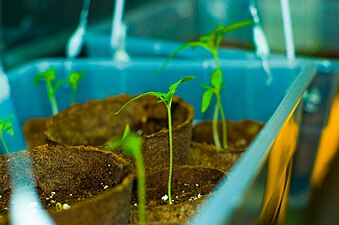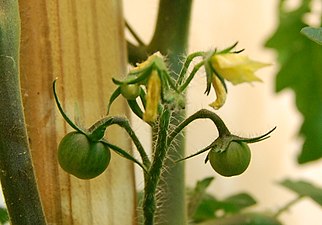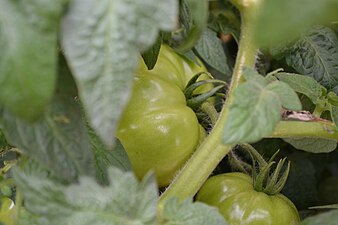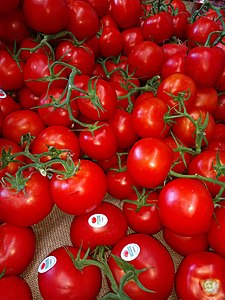Tomato
| Tomato | |
|---|---|

| |
| Scientific classification | |
| Kingdom: | Plantae |
| Clade: | Tracheophytes |
| Clade: | Angiosperms |
| Clade: | Eudicots |
| Clade: | Asterids |
| Order: | Solanales |
| Family: | Solanaceae |
| Genus: | Solanum |
| Species: | S. lycopersicum
|
| Binomial name | |
| Solanum lycopersicum | |
| Synonyms[1] | |
| |
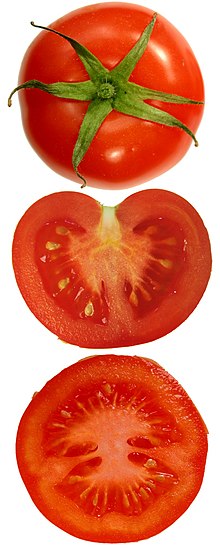
Thetomato(/təmeɪtoʊ/or/təmɑːtoʊ/) is the edibleberryof the plantSolanum lycopersicum,[1][2]commonly known as the tomato plant. The species originated in westernSouth America,Mexico,andCentral America.[2][3]Its domestication and use as acultivatedfood may have originated with theindigenous peoples of Mexico.[2][4]TheAztecsused tomatoes in their cooking at the time of theSpanish conquest of the Aztec Empire,and after the Spanish encountered the tomato for the first time after their contact with theAztecs,they brought the plant to Europe, in a widespread cultural interchange known as theColumbian exchange.From there, the tomato was introduced to other parts of the European-colonized world during the 16th century.[2]
Tomatoes are a significant source ofumamiflavor.[5]They are consumed in diverse ways: raw or cooked, and in many dishes, sauces,salads,and drinks. While tomatoes arefruits—botanicallyclassified as berries—they are commonly usedculinarilyas avegetableingredient orside dish.[3]
Numerous varieties of the tomato plant are widely grown intemperate climatesacross the world, withgreenhousesallowing for the production of tomatoes throughout all seasons of the year. Tomato plants typically grow to 1–3 meters (3–10 ft) in height. They arevinesthat have a weakstemthat sprawls and typically needs support.[2]Indeterminate tomato plants areperennialsin their native habitat, but are cultivated asannuals.(Determinate, or bush, plants are annuals that stop growing at a certain height and produce a crop all at once.) The size of the tomato varies according to thecultivar,with a range of1–10 cm (1⁄2–4 in) in width.[2]
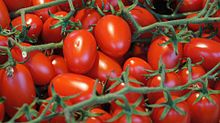
History

The wild ancestor of the tomato,Solanum pimpinellifolium,is native to western South America.[6]These wild versions were the size of peas.[6]The first evidence of domestication points to theAztecsand other peoples inMesoamerica,who used the fruit fresh and in their cooking. The Spanish first introduced tomatoes to Europe, where they became used in Spanish food. In France, Italy and northern Europe, the tomato was initially grown as an ornamental plant. It was regarded with suspicion as a food because botanists recognized it as anightshade,a relative of the poisonousbelladonna.[3]This was exacerbated by the interaction of the tomato's acidic juice withpewterplates.[7]The leaves and fruit containtomatine,which in large quantities would be toxic. However, the ripe fruit contains a much lower amount of tomatine than the immature fruit.[8]
Mesoamerica
The exact date of domestication is unknown; by 500 BC, it was already being cultivated in southernMexicoand probably other areas.[9]: 13 ThePueblopeople are thought to have believed that those who witnessed the ingestion of tomato seeds were blessed with powers ofdivination.[10]The large, lumpy variety of tomato, a mutation from a smoother, smaller fruit, originated in Mesoamerica, and may be the direct ancestor of some modern cultivated tomatoes.[9]: 15
The Aztecs raised several varieties of tomato, with red tomatoes calledxitomatland green tomatoes (physalis) calledtomatl(tomatillo).[11]Bernardino de Sahagúnreported seeing a great variety of tomatoes in the Aztec market at Tenochtitlán (Mexico City): "large tomatoes, small tomatoes, leaf tomatoes, sweet tomatoes, large serpent tomatoes, nipple-shaped tomatoes", and tomatoes of all colors from the brightest red to the deepest yellow.[12]Bernardino de Sahagún mentioned Aztecs cooking various sauces, some with and without tomatoes of different sizes, serving them in city markets: "foods sauces, hot sauces; fried [food], olla-cooked [food], juices, sauces of juices, shredded [food] withchile,withsquashseeds [most likelyCucurbita pepo], with tomatoes, with smoked chile, with hot chile, with yellow chile, with mild red chile sauce, yellow chile sauce, hot chile sauce, with "bird excrement" sauce, sauce of smoked chile, heated [sauces], bean sauce; [he sells] toasted beans, cooked beans, mushroom sauce, sauce of small squash, sauce of large tomatoes, sauce of ordinary tomatoes, sauce of various kinds of sour herbs,avocadosauce. "[13]
Spanish distribution
SpanishconquistadorHernán Cortésmay have been the first to transfer a small yellow tomato to Europe after he captured the Aztec city ofTenochtitlan,now Mexico City, in 1521. The earliest discussion of the tomato in European literature appeared in aherbalwritten in 1544 byPietro Andrea Mattioli,an Italian physician and botanist, who suggested that a new type ofeggplanthad been brought to Italy that was blood red or golden color when mature and could be divided into segments and eaten like an eggplant—that is, cooked and seasoned with salt, black pepper, and oil. It was not until ten years later that tomatoes were named in print by Mattioli aspomi d'oro,or "golden apples".[9]: 13
After theSpanish colonization of the Americas,the Spanish distributed the tomato throughout their colonies in theCaribbean.They also took it to thePhilippines,from where it spread tosoutheast Asiaand then the entire Asian continent. The Spanish also brought the tomato to Europe. It grew easily inMediterranean climates,and cultivation began in the 1540s. It was probably eaten shortly after it was introduced, and was certainly being used as food by the early 17th century in Spain.
China
The tomato was introduced to China, likely via the Philippines or Macau, in the 1500s. It was given the name cà chuafānqié(foreign eggplant), as the Chinese named many foodstuffs introduced from abroad, but referring specifically to early introductions.[14]
Italy

The recorded history of tomatoes in Italy dates back to at least 31 October 1548, when the house steward ofCosimo de' Medici,the grand duke ofTuscany,wrote to the Medici private secretary informing him that the basket of tomatoes sent from the grand duke's Florentine estate atTorre del Gallo"had arrived safely".[15]Tomatoes were grown mainly as ornamentals early on after their arrival in Italy. For example, the Florentine aristocrat Giovanvettorio Soderini wrote how they "were to be sought only for their beauty", and were grown only in gardens or flower beds. The tomato's ability to mutate and create new and different varieties helped contribute to its success and spread throughout Italy. However, in areas where the climate supported growing tomatoes, their habit of growing to the ground suggested low status. They were not adopted as a staple of the peasant population because they were not as filling as other fruits already available. Additionally, both toxic and inedible varieties discouraged many people from attempting to consume or prepare any other varieties.[16]In certain areas of Italy, such as Florence, the fruit was used solely as a tabletop decoration, until it was incorporated into the local cuisine in the late 17th or early 18th century.[17]The earliest discovered cookbook with tomato recipes was published inNaplesin 1692, though the author had apparently obtained these recipes from Spanish sources.[9]: 17
Unique varieties were developed over the next several hundred years for uses such as dried tomatoes, sauce tomatoes, pizza tomatoes, and tomatoes for long-term storage. These varieties are usually known for their place of origin as much as by a variety name. For example there is thePomodorino del Piennolo del Vesuvio,the "hanging tomato of Vesuvius", or the well known and highly prizedSan Marzanoplum tomatogrown in that region.[This paragraph needs citation(s)]
Britain
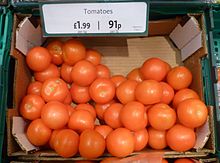
Tomatoes were not grown in England until the 1590s. One of the earliest cultivators wasJohn Gerard,abarber-surgeon.Gerard'sHerbal,published in 1597, and largelyplagiarizedfrom continental sources, is also one of the earliest discussions of the tomato in England. Gerard knew the tomato was eaten in Spain and Italy. Nonetheless, he believed it was poisonous. (In fact, the plant and raw fruit do have low levels oftomatine,but are not generally dangerous.See below.) Gerard's views were influential, and the tomato was considered unfit for eating (though not necessarily poisonous) for many years inBritainand itsNorth American colonies.[9]: 17
However, by the mid-18th century, tomatoes were widely eaten in Britain, and before the end of that century, theEncyclopædia Britannicastated the tomato was "in daily use" insoups,broths,and as agarnish.They were not part of the average person's diet, and though by 1820 they were described as "to be seen in great abundance in all our vegetable markets" and to be "used by all our best cooks", reference was made to their cultivation in gardens still "for the singularity of their appearance", while their use in cooking was associated with exotic Italian or Jewish cuisine.[18]For example, inElizabeth Blackwell'sA Curious Herbal,it is described under the name "Love Apple (Amoris Pomum)" as being consumed with oil and vinegar in Italy, similar to consumption of cucumbers in the UK.[19]
Middle East

The tomato was introduced to cultivation in the Middle East byJohn Barker,British consul inAleppoc. 1799 to 1825.[20][21]Nineteenth century descriptions of its consumption are uniformly as an ingredient in a cooked dish. In 1881, it is described as only eaten in the region "within the last forty years".[22]Today, the tomato is a crucial and ubiquitous part ofMiddle Eastern cuisine,served fresh in salads (e.g.,Arab salad,Israeli salad,Shirazi saladandTurkish salad), grilled withkebabsand other dishes, made into sauces, and so on.[23]
United States

The earliest reference to tomatoes being grown inBritish North Americais from 1710, when herbalistWilliam Salmonreported seeing them in what is todaySouth Carolina.[9]: 25 They may have been introduced from the Caribbean. By the mid-18th century, they were cultivated on some Carolina plantations, and probably in other parts of the Southeast as well.Thomas Jefferson,who ate tomatoes in Paris, sent some seeds back to America.[9]: 28 Some early American advocates of the culinary use of the tomato includedMichele Felice CornèandRobert Gibbon Johnson.[24]Many Americans considered tomatoes to be poisonous at this time and, in general, they were grown more asornamental plantsthan as food. In 1897, W. H. Garrison addressed the Medico-Legal Society of New York stating, "The belief was once transmitted that the tomato was sinisterly dangerous." He recalled in his youth tomatoes were dubbed "love-apples or wolf-apples" and they were shunned as "globes of the devil."[25]
Alexander W. Livingstonreceives much credit for developing numerous varieties of tomato for both home and commercial gardeners.[26]
Early tomato breeders included Henry Tilden in Iowa and a Dr. Hand in Baltimore.[27] The U.S. Department of Agriculture's 1937 yearbook declared that "half of the major varieties were a result of the abilities of the Livingstons to evaluate and perpetuate superior material in the tomato." Livingston's first breed of tomato, the Paragon, was introduced in 1870, the beginning of a great tomato culture enterprise in the county. In 1875, he introduced the Acme, which was said to be involved in the parentage of most of the tomatoes introduced by him and his competitors for the next twenty-five years.[28][29]
When Livingston began his attempts to develop the tomato as a commercial crop, his aim had been to grow tomatoes smooth in contour, uniform in size, and sweet in flavor. He eventually developed over seventeen different varieties of the tomato plant.[28]Today, the crop is grown in every state in the Union.[30]
Because of the long growing season needed for this heat-loving crop, several states in the USSun Beltbecame major tomato-producers, particularlyFloridaandCalifornia.In California, tomatoes are grown underirrigationfor both the fresh fruit market and forcanningand processing. TheUniversity of California, Davis(UC Davis) became a major center for research on the tomato. The C.M. Rick Tomato Genetics Resource Center at UC Davis is a gene bank of wild relatives, monogenic mutants and miscellaneous genetic stocks of tomato.[31]The center is named for the late Dr.Charles M. Rick,a pioneer in tomato genetics research.[32]Research on processing tomatoes is also conducted by the California Tomato Research Institute inEscalon, California.[33]
In California, growers have used a method of cultivation calleddry-farming,especially withEarly Girltomatoes. This technique encourages the plant to send roots deep to find existing moisture in soil that retains moisture, such as clayey soil.
Modern commercial varieties



The poor taste and lack of sugar in modern garden and commercial tomato varieties resulted from breeding tomatoes to ripen uniformly red. This change occurred after discovery of a mutant "u"phenotypein the mid-20th century, so named because the fruits ripened uniformly. This was widely cross-bred to produce red fruit without the typical green ring around the stem on un-crossbred varieties. Prior to general introduction of this trait, most tomatoes produced more sugar during ripening, and were sweeter and more flavorful.[34][35]
Evidence has been found that 10–20% of the total carbon fixed in the fruit can be produced by photosynthesis in the developing fruit of the normal U phenotype. The u genetic mutation encodes a factor that produces defective chloroplasts with lower density in developing fruit, resulting in a lighter green colour of unripe fruit, and repression of sugars accumulation in the resulting ripe fruit by 10–15%. Perhaps more important than their role in photosynthesis, the fruit chloroplasts are remodelled during ripening into chlorophyll-freechromoplaststhat synthesize and accumulate thecarotenoidslycopene,β-carotene,and other metabolites that are sensory and nutritional assets of the ripe fruit. The potent chloroplasts in the dark-green shoulders of the U phenotype are beneficial here, but have the disadvantage of leaving green shoulders near the stems of the ripe fruit, and even cracked yellow shoulders, apparently because of oxidative stress due to overload of the photosynthetic chain in direct sunlight at high temperatures. Hence genetic design of a commercial variety that combines the advantages of types u and U requires fine tuning, but may be feasible.[36]
Furthermore, breeders of modern tomato cultivars typically strive to produce tomato plants exhibiting improved yield, shelf life, size, and tolerance/resistance to various environmental pressures, including disease.[37][38]However, these breeding efforts have yielded unintended negative consequences on various tomato fruit attributes. For instance, linkage drag is a phenomenon that has been responsible for alterations in the metabolism of the tomato fruit. Linkage drag describes the introduction of an undesired trait or allele into a plant during backcrossing. This trait/allele is physically linked (or is very close) to the desired allele along the chromosome. In introducing the beneficial allele, there exists a high likelihood that the poor allele is also incorporated into the plant. Thus, breeding efforts attempting to enhance certain traits (for example: larger fruit size) have unintentionally altered production of chemicals associated with, for instance, nutritional value and flavor.[37]
Breeders have turned to using wild tomato species as a source of alleles for the introduction of beneficial traits into modern tomato varieties. For example, wild tomato relatives may possess higher amounts of fruit solids (which are associated with greater sugar content) or resistance to diseases caused by microbes, such as resistance towards the early blight pathogenAlternaria solani.However, this tactic has limitations, for the incorporation of certain traits, such as pathogen resistance, can negatively impact other favorable phenotypes, such as fruit production.[38][39]
Etymology

The wordtomatocomes from the Spanishtomate,which in turn comes from theNahuatlwordtomatl[ˈtomat͡ɬ],meaning "swelling fruit".[40]Thespecific namelycopersicum,meaning "wolf peach", originated withGalen,who used it to denote a plant that has not been identified.Luigi Anguillaraspeculated in the 16th century that Galen'slycopersicummight be the tomato, and despite the impossibility of this identification,lyocpersicumentered scientific use as a name for the fruit.[41]
Pronunciation
The usual pronunciations oftomatoare/təˈmeɪtoʊ/tə-MAY-toh(usual inNorth American English) and/təˈmɑːtoʊ/tə-MAH-toh(usual inBritish English).[42]The word'sdual pronunciationswere immortalized inIraandGeorge Gershwin's 1937 song "Let's Call the Whole Thing Off"(" You like/pəˈteɪtoʊ/and I like/pəˈtɑːtoʊ// You like/təˈmeɪtoʊ/and I like/təˈmɑːtoʊ/") and have become a symbol fornitpickingpronunciation disputes.[citation needed]In this capacity, it has even become an American and British slang term: saying "/təˈmeɪtoʊtəˈmɑːtoʊ/"when presented with two choices can mean" What's the difference? "or" It's all the same to me ".[43]
Botany
Description
This sectionneeds additional citations forverification.(April 2022) |

Tomato plants are vines, initiallydecumbent,and could grow up to 3 m (9.8 ft), although erect bush varieties have been bred, generally 100 cm (3 ft 3 in) tall or shorter. Indeterminate types are "tender" perennials, dying annually in temperate climates (they are originally native to tropical highlands), although they can live up to three years in a greenhouse in some cases. Determinate types are annual in all climates.[44]
Tomato plants aredicots,and grow as a series of branching stems, with a terminal bud at the tip that does the actual growing. When the tip eventually stops growing, whether because of pruning or flowering, lateral buds take over and grow into other, fully functional, vines.[45]
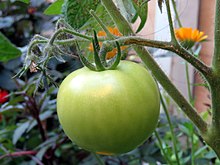
Tomato vines are typically pubescent, meaning covered with fine short hairs. The hairs facilitate the vining process, turning into roots wherever the plant is in contact with the ground and moisture, especially if the vine's connection to its original root has been damaged or severed.[citation needed]
Most tomato plants havecompound leaves,and are called regular leaf (RL) plants, but some cultivars have simple leaves known aspotato leaf(PL) style because of their resemblance to that particular relative. Of RL plants, there are variations, such as rugose leaves, which are deeply grooved, andvariegated,angora leaves, which have additional colors where a genetic mutation causeschlorophyllto be excluded from some portions of the leaves.[46][unreliable source?]
Theleavesare 10–25 cm (4–10 in) long, odd pinnate, with five to nine leaflets on petioles,[47]each leaflet up to 8 cm (3 in) long, with a serrated margin; both the stem and leaves are densely glandular-hairy.[citation needed]
Theirflowers,appearing on the apicalmeristem,have the anthers fused along the edges, forming a column surrounding thepistil's style. Flowers are bisexual and able to self fertilise. The anthers bend into a cone-like structure, surrounding the stigma.[48]The flowers are1–2 cm (1⁄2–3⁄4in) across, yellow, with five pointed lobes on thecorolla;they are borne in acymeof three to twelve together.[citation needed]
Although inculinaryterms, tomato is regarded as a vegetable, its fruit is classifiedbotanicallyas aberry.[49]As a true fruit, it develops from the ovary of the plant after fertilization, its flesh comprising the pericarp walls. The fruit contains hollow spaces full of seeds and moisture, called locular cavities. These vary, among cultivated species, according to type. Some smaller varieties have two cavities, globe-shaped varieties typically have three to five,beefsteak tomatoeshave a great number of smaller cavities, whilepaste tomatoeshave very few, very small cavities.[50][51][52]
For propagation, the seeds need to come from a mature fruit, and must be lightly fermented to remove the gelatinous outer coating and then dried before use.[53]
Classification
In 1753,Linnaeusplaced the tomato in thegenusSolanum(alongside thepotato) asSolanum lycopersicum.In 1768,Philip Millermoved it to its own genus, naming itLycopersicon esculentum.[54]The name came into wide use, but was technically in breach of theplant naming rulesbecause Linnaeus's species namelycopersicumstill had priority. Although the nameLycopersicum lycopersicumwas suggested by Karsten (1888), it is not used because it violates the International Code of Nomenclature[55]barring the use oftautonymsin botanical nomenclature. The corrected nameLycopersicon lycopersicum(Nicolson 1974) was technically valid, because Miller's genus name and Linnaeus's species name differ in exact spelling, but sinceLycopersicon esculentumhas become so well known, it was officially listed as anomen conservandumin 1983, and would be the correct name for the tomato in classifications which do not place the tomato in the genusSolanum.[citation needed]
Geneticevidence has now shown that Linnaeus was correct to put the tomato in the genusSolanum,makingSolanum lycopersicumthe correct name.[1][56]Both names, however, will probably be found in the literature for some time. Two of the major reasons for considering the genera separate are the leaf structure (tomato leaves are markedly different from any otherSolanum), and the biochemistry (many of the alkaloids common to otherSolanumspecies are conspicuously absent from the tomato). On the other hand, hybrids of tomato and diploidpotatocan be created in the lab bysomatic fusion,and are partially fertile,[57]providing evidence of the close relationship between these species.
Genetics and genetic modification
Genome
| NCBIgenome ID | GCF_000188115.5 |
|---|---|
| Specimen sequenced | Heinz 1706 |
| Ploidy | haploid |
| Genome size | 827.4 Mb |
| Number ofchromosomes | 12 |
| Number ofgenes | 31,217 |
| Protein-coding | 25,557 |
| Year of completion | 2018 |
An international consortium of researchers from 10 countries, began sequencing the tomatogenomein 2004.[58][59]A prerelease version of the genome was made available in December 2009.[60]The complete genome for the cultivar Heinz 1706 was published on 31 May 2012 inNature.[61]The latest reference genome published in 2021 had 799 MB and encodes 34,384 (predicted) proteins, spread over 12 chromosomes.[62]
Genetic modification
Since many other fruits, likestrawberries,apples,melons,andbananasshare the same characteristics and genes, researchers stated the published genome could help to improve food quality, food security and reduce costs of all of these fruits.[63]
The first commercially availablegenetically modified foodwas a tomato calledFlavr Savr,which was engineered to have a longer shelf life.[64]However, it is no longer commercially available. Scientists are continuing to develop tomatoes with new traits not found in natural crops, such as increased resistance to pests or environmental stresses or better flavor.[citation needed]
Breeding
The Tomato Genetic Resource Center,Germplasm Resources Information Network,AVRDC,and numerousseed banksaround the world store seed representing genetic variations of value to modern agriculture. These seed stocks are available for legitimate breeding and research efforts. While individual breeding efforts can produce useful results, the bulk of tomato breeding work is at universities and major agriculture-related corporations. These efforts have resulted in significant regionally adapted breeding lines and hybrids, such as the Mountain series from North Carolina. Corporations includingHeinz,Monsanto,BHNSeed, and Bejoseed have breeding programs that attempt to improve production, size, shape, color, flavor, disease tolerance, pest tolerance, nutritional value, and numerous other traits.[citation needed]
Fruit versus vegetable
Botanically,a tomato is afruit—aberry,consisting of theovary,together with its seeds, of aflowering plant.[65]However, the tomato is considered a "culinary vegetable"because it has a much lower sugar content thanculinary fruits;because it is more savoury (umami) than sweet, it is typically served as part of a salad ormain courseof a meal, rather than as adessert.[66]Tomatoes are not the only food source with this ambiguity;bell peppers,cucumbers,green beans,aubergines/eggplants,avocados,andsquashesof all kinds (such ascourgettes/zucchiniandpumpkins) are all botanically fruit, yet cooked as vegetables.[67]
The confusion on whether tomatoes are fruits or vegetables has led to legal dispute in the United States. In 1887, U.S.tarifflaws that imposed adutyon vegetables, but not on fruit, caused the tomato's status to become a matter of legal importance. InNix v. Hedden,theU.S. Supreme Courtsettled the tariff controversy on 10 May 1893, by declaring that the tomato is a vegetable, based on the popular definition that classifies vegetables by use—they are generally served with dinner and not dessert.[68]The holding of this case applies only to the interpretation of theTariff of 1883,and the court did not purport to reclassify the tomato for botanical or other purposes.
Cultivation
The tomato is grown worldwide for its ediblefruits,with thousands ofcultivars.[69]A fertilizer with anNPK ratioof 5–10–10 is often sold as tomato fertilizer or vegetable fertilizer,[citation needed]although manure and compost are also used.[citation needed]On average there are 150,000 seeds in a pound of tomato seeds.[70]
Diseases


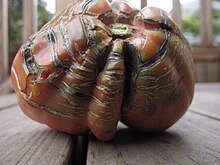
Tomato cultivars vary widely in their resistance to disease. Modernhybridsfocus on improving disease resistance over theheirloom plants.
Various forms ofmildewandblightare common tomato afflictions, which is why tomato cultivars are often marked with a combination of letters that refer to specific disease resistance. The most common letters are:
- LB– 'late blight'[71]
- V–verticilliumwilt
- F–fusariumwiltstrain I
- FF–fusariumwilt strain I and II
- N–nematodes
- T–tobacco mosaic virus,and
- A–alternaria.
A common tomato disease istobacco mosaic virus.Handling cigarettes and other infected tobacco products can transmit the virus to tomato plants.[72]
Another particularly dreaded disease iscurly top,carried by thebeet leafhopper,which interrupts the lifecycle. As the name implies, it has the symptom of making the top leaves of the plant wrinkle up and grow abnormally.[citation needed]
Bacterial wiltis another common disease impacting yield.[73]Wanget al.,2019 foundphage combination therapiesto reduce the impact of bacterial wilt, sometimes by reducing bacterial abundance and sometimes byselectingforresistantbut slow growing genetics.[73]
Pests
Some common tomato pests are thetomato bug,stink bugs,cutworms,tomato hornwormsandtobacco hornworms,aphids,cabbage loopers,whiteflies,tomato fruitworms,flea beetles,red spider mite,slugs,[74]andColorado potato beetles.The tomato russetmite,Aculops lycopersici,feeds on foliage and young fruit of tomato plants, causing shrivelling andnecrosisof leaves, flowers, and fruit, possibly killing the plant.[75]
After an insect attack tomato plants producesystemin,aplant peptide hormone.Systemin activates defensive mechanisms, such as the production ofprotease inhibitorsto slow the growth of insects. The hormone was first identified in tomatoes, but similar proteins have been identified in other species since.[76]
Other disorders
Although not a disease as such, irregular supplies of water can cause growing or ripening fruit to split. Besides cosmetic damage, the splits may allow decay to start, although growing fruits have some ability to heal after a split. In addition, a deformity calledcat-facingcan be caused by pests, temperature stress, or poor soil conditions. Affected fruit usually remains edible, but its appearance may be unsightly.
Companion plants
Tomatoes serve, or are served by, a large variety ofcompanion plants.
The devastating tomato hornworm has a major predator in variousparasitic wasps,whose larvae devour the hornworm, but whose adult form drinks nectar from tiny-flowered plants likeumbellifers.Several species of umbellifer are therefore often grown with tomato plants, includingparsley,Queen Anne's lace,and occasionallydill.These also attractpredatory fliesthat attack various tomato pests.[77]
Borageis thought to repel thetomato hornwormmoth.[78]
Basilis popularly recommended as a companion plant to the tomato. Common claims are that basil may deter pests or improve tomato flavor. However, in double-blind taste tests, basil did not significantly affect the taste of tomatoes when planted adjacent to them.[79][80]
Tomato plants can protectasparagusfromasparagus beetles,because they containsolaninethat kills this pest,[citation needed]while asparagus plants containasparagusic acidthat repelsnematodesknown to attack tomato plants.[81]Marigolds also repel nematodes.[82][83][84]
Pollination


In the wild, original state, tomatoes required cross-pollination;they were much moreself-incompatiblethan domestic cultivars. As a floral device to reduce selfing, thepistilof wild tomatoes extends farther out of the flower than today's cultivars. Thestamenswere, and remain, entirely within the closedcorolla.
As tomatoes were moved from their native areas, their traditionalpollinators(probably a species ofhalictid bee) did not move with them.[85]The trait of self-fertility became an advantage, and domesticcultivarsof tomato have been selected to maximize this trait.[85]
This is not the same asself-pollination,despite the common claim that tomatoes do so. That tomatoes pollinate themselves poorly without outside aid is clearly shown ingreenhousesituations, where pollination must be aided by artificial wind, vibration of the plants (one brand ofvibratoris a wand called an "electric bee" that is used manually), or more often today, by culturedbumblebees.[86]Theantherof a tomato flower is shaped like a hollow tube, with thepollenproduced within the structure, rather than on the surface, as in most species. The pollen moves through pores in the anther, but very little pollen is shed without some kind of externally-induced motion. The ideal vibratory frequencies to release pollen grains are provided by an insect, such as a bumblebee, or the original wild halictid pollinator, capable of engaging in a behavior known asbuzz pollination,whichhoney beescannot perform. In an outdoors setting, wind or animals usually provide sufficient motion to produce commercially viable crops.[citation needed]
Fruit formation
Pollination and fruit formation depend onmeiosis.Meiosis is central to the processes by which diploid microspore mother cells within the anther give rise to haploid pollen grains, and megaspore mother cells in ovules that are contained within the ovary give rise to haploid nuclei. Union of haploid nuclei from pollen and ovule (fertilization) can occur either by self- or cross-pollination. Fertilization leads to the formation of a diploid zygote that can then develop into an embryo within the emerging seed. Repeated fertilizations within the ovary are accompanied by maturation of the ovary to form the tomato fruit.
Homologs of therecAgene, includingrad51,play a key role in homologous recombinational repair of DNA during meiosis. Arad51homolog is present in the anther of tomato (Lycopersicon esculentum),[87]suggesting that recombinational repair occurs during meiosis in tomato.
Hydroponic and greenhouse cultivation

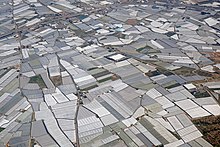
Tomatoes are often grown ingreenhousesin cooler climates, and cultivars such as the British 'Moneymaker' and a number of cultivars grown inSiberiaare specifically bred for indoor growing. In moretemperate climates,it is not uncommon to start seeds in greenhouses during the late winter for future transplant.
Greenhouse tomato production in large-acreage commercial greenhouses and owner-operator stand-alone or multiple-bay greenhouses is on the increase, providing fruit during those times of the year when field-grown fruit is not readily available. Smaller sized fruit (cherry and grape), or cluster tomatoes (fruit-on-the-vine) are the fruit of choice for the large commercial greenhouse operators while the beefsteak varieties are the choice of owner-operator growers.[88]
Hydroponictechnique is often used in hostile growing environments, as well as high-density plantings.
Picking and ripening
To facilitate transportation and storage, tomatoes are often picked unripe (green) and ripened in storage withethylene.[89]
A machine-harvestable variety of tomato (the "square tomato" ) was developed in the 1950s byUniversity of California, Davis'sGordie C. Hanna,which, in combination with the development of a suitable harvester, revolutionized the tomato-growing industry. This type of tomato is grown commercially near plants that process and can tomatoes, tomato sauce, and tomato paste. They are harvested when ripe and are flavorful when picked. They are harvested 24 hours a day, seven days a week during a 12- to 14-week season, and immediately transported to packing plants, which operate on the same schedule. California is a center of this sort of commercial tomato production and produces about a third of the processed tomatoes produced in the world.[90]
In 1994,Calgeneintroduced agenetically modified tomatocalled theFlavrSavr,which could be vine ripened without compromisingshelf life.However, the product was not commercially successful, and was sold only until 1997.[91]
Yield
The world dedicated 4.8 millionhectaresin 2012 for tomato cultivation and the total production was about 161.8 milliontonnes.[92]The average world farm yield for tomato was 33.6 tonnes per hectare in 2012.[92]
Tomato farms in theNetherlandswere the most productive in 2012, with a nationwide average of 476 tonnes per hectare, followed byBelgium(463 tonnes per hectare) andIceland(429 tonnes per hectare).[93]
Records

As of 2008[update],the heaviest tomato harvested weighed 3.51 kg (7 lb 12 oz), was of the cultivar "Delicious", and was grown by Gordon Graham ofEdmond, Oklahomain 1986.[94][unreliable source?]The largest tomato plant grown was of the cultivar "Sungold" and reached 19.8 m (65 ft) in length, grown by Nutriculture Ltd (UK) of Mawdesley, Lancashire, UK, in 2000.[95]
A massive "tomato tree" growing inside theWalt Disney World Resort's experimental greenhouses inLake Buena Vista, Floridamay have been the largest single tomato plant in the world. The plant has been recognized as a Guinness World Record Holder, with a harvest of more than 32,000 tomatoes and a total weight of 522 kg (1,151 lb).[96]It yielded thousands of tomatoes at one time from a single vine. Yong Huang,Epcot's manager of agricultural science, discovered the unique plant in Beijing, China. Huang brought its seeds to Epcot and created the specialized greenhouse for the fruit to grow. The vine grewgolf ball-sized tomatoes, which were served at Walt Disney World restaurants.[97]The tree developed a disease and was removed in April 2010 after about 13 months of life.[original research]
-
Tomato plants 7 days after planting
-
Tomato seedlings growing indoors
-
27 days after planting
-
52-day-old plant, first fruits
-
Tomatoes being collected from the field,Maharashtra,India
Production
| Tomato production – 2022 | |
|---|---|
| Producer | (Millions oftonnes) |
| 68.2 | |
| 20.7 | |
| 13.0 | |
| 10.2 | |
| 6.3 | |
| 4.2 | |
| World | 186.2 |
| Source:FAOSTATof theUnited Nations[98] | |
In 2022, world production of tomatoes was 186 milliontonnes,with China accounting for 37% of the total, followed byIndia,Turkey,and theUnited Statesas major producers (table).
Toxicity
The leaves, stem, and green unripe fruit of the tomato plant contain small amounts of the alkaloidtomatine,whose effect on humans has not been studied.[8]They also contain small amounts ofsolanine,a toxic alkaloid found inpotatoleaves and other plants in thenightshade family.[99][100]However, solanine concentrations in foliage and green fruit are generally too small to be dangerous unless large amounts are consumed—for example, asgreens.
Small amounts of tomato foliage are sometimes used for flavoring without ill effect, and the green fruit of unripe red tomato varieties is sometimes used for cooking, particularly asfried green tomatoes.[8]There are also tomato varieties with fully ripe fruit that is still green. Compared to potatoes, the amount of solanine in unripe green or fully ripe tomatoes is low. However, even in the case of potatoes, while solanine poisoning resulting from dosages several times the normal human consumption has been demonstrated, actual cases of poisoning from excessive consumption of potatoes are rare.[100]
Tomato plants can be toxic to dogs if they eat large amounts of the fruit, or chew plant material.[101]
Salmonella
Tomatoes were linked to sevenSalmonellaoutbreaks between 1990 and 2005,[102]and may have been the cause of asalmonellosisoutbreak causing 172 illnesses in 18 US states in 2006.[103]The2008 United States salmonellosis outbreakcaused the temporary removal of tomatoes from stores and restaurants across the United States and parts of Canada,[104]although other foods, includingjalapeñoandserrano peppers,may have been involved.
Uses
Culinary

Though it is botanically aberry,a subset offruit,the tomato is considered avegetablefor culinary purposes. It has a strong savouryumamiflavour, rather than significant sweetness (seeabove).ChefHeston Blumenthalobserved that the inner pulp had more flavour that the flesh; a subsequent academic study in which he participated confirmed that the pulp had up to eleven times moreglutamic acid,which carries umami flavour, than the flesh.[105]
Although tomatoes originated in the Americas, the tomato is now grown and eaten around the world. It is used in diverse ways, including raw insaladsor in slices, stewed, incorporated into a wide variety of dishes, or processed intoketchuportomato soup.Unripe green tomatoes can also bebreaded and fried,used to makesalsa,or pickled.Tomato juiceis sold as adrink,and is used in cocktails such as theBloody Mary.
Tomatoes have become extensively used inMediterranean cuisineas a key ingredient inpizzaand manypastasauces.[5]Tomatoes are also used inSpanishandCatalandishes, such asgazpachoandpa amb tomàquet.Tomato became a key ingredient in manycurrydishes inSouth Asiaafter they were introduced to the region by the Portuguese in the 15th century.
Storage
Tomatoes keep best unwashed atroom temperatureand out of direct sunlight. It is not recommended to refrigerate them as they take a mealy texture and lose flavour.[106][107]
Storing stem down can prolongshelf life,[108]as it may keep from rotting too quickly.[109]
Unripe tomatoes can be kept in a paper bag to ripen.[110]
Tomatoes are easy to preserve whole, chopped, or astomato sauceorconcentrated pastebyhome canning.The fruit can also be preservedby drying,sometimes in the sun where climate permits, and sold either in bags or in jars with oil.
Nutrition
| Nutritional value per 100 g (3.5 oz) | |||||||||||||||||||||||||||||||||||||||||||||||||
|---|---|---|---|---|---|---|---|---|---|---|---|---|---|---|---|---|---|---|---|---|---|---|---|---|---|---|---|---|---|---|---|---|---|---|---|---|---|---|---|---|---|---|---|---|---|---|---|---|---|
| Energy | 74 kJ (18 kcal) | ||||||||||||||||||||||||||||||||||||||||||||||||
3.9 g | |||||||||||||||||||||||||||||||||||||||||||||||||
| Sugars | 2.6 g | ||||||||||||||||||||||||||||||||||||||||||||||||
| Dietary fiber | 1.2 g | ||||||||||||||||||||||||||||||||||||||||||||||||
0.2 g | |||||||||||||||||||||||||||||||||||||||||||||||||
0.9 g | |||||||||||||||||||||||||||||||||||||||||||||||||
| |||||||||||||||||||||||||||||||||||||||||||||||||
| Other constituents | Quantity | ||||||||||||||||||||||||||||||||||||||||||||||||
| Water | 94.5 g | ||||||||||||||||||||||||||||||||||||||||||||||||
| Lycopene | 2573 μg | ||||||||||||||||||||||||||||||||||||||||||||||||
| †Percentages estimated usingUS recommendationsfor adults,[111]except for potassium, which is estimated based on expert recommendation fromthe National Academies.[112] | |||||||||||||||||||||||||||||||||||||||||||||||||
A raw tomato is 95% water, contains 4%carbohydrates,and has less than 1% each offatandprotein(see table). 100 grams (3.5 oz) of raw tomatoes supply 18 kilocaloriesand are a moderate source ofvitamin C(17% of theDaily Value), but otherwise have lowmicronutrientcontent (table).
Research
An extensive review in 2022 found and specified many health benefits associated with eating tomatoes, and some risks, due both to external factors (pesticides, microbial contamination, heavy metals from contaminated soil), and intrinsic; for example, lycopene, at least as a supplement, has anti-plateleteffect undesirable for patients onblood thinnersand similar medications. The review concludes that "the synergistic effects of all tomato constituents are likely to outweigh the benefits of tomato's individual constituents, such as lycopene".[113]
Studies in 2014 and 2015 did not find conclusive evidence to indicate that thelycopenein tomatoes or insupplementsaffects the onset ofcardiovascular diseasesorcancer.[114][115]
In the United States, supposed health benefits of consuming tomatoes, tomato products or lycopene to affect cancer cannot be mentioned on packaged food products without a qualifiedhealth claimstatement.[116]In a scientific review of potential claims for lycopene favorably affectingDNA,skin exposed toultraviolet radiation,heart function and vision, theEuropean Food Safety Authorityconcluded in 2011 that the evidence for lycopene having any of these effects was inconclusive.[117]
Host plant
The potato tuber moth (Phthorimaea operculella) is an oligophagous insect that prefers to feed on plants of the family Solanaceae such as tomato plants. FemaleP. operculellause the leaves to lay their eggs and the hatched larvae will eat away at themesophyllof the leaf.[118]
Tomato forms a mutually beneficialsymbiosiswitharbuscular mycorrhizalfungi such asRhizophagus irregularis.Scientists use tomato as amodel speciesfor investigating this symbiosis.[119]
In popular culture
The town ofBuñol,Spain, annually celebratesLa Tomatina,a festival centered on an enormous tomato fight. On 30 August 2007, 40,000 Spaniards gathered to throw 115,000 kg (254,000 lb) of tomatoes at each other in thefestival.[120]

Several US states have adopted the tomato as a state fruit or vegetable (seeabove). Tomatoes have been designated the state vegetable ofNew Jersey.Arkansastook both sides by declaring theSouth Arkansas Vine Ripe Pink Tomatoboth the state fruit and the state vegetable in the same law, citing both its culinary and botanical classifications. In 2009, the state ofOhiopassed a law making the tomato the state's official fruit. Tomato juice has been the official beverage of Ohio since 1965.Alexander W. Livingston,ofReynoldsburg, Ohio,played a large part in popularizing the tomato in the late 19th century; his efforts are commemorated in Reynoldsburg with an annual Tomato Festival.
Flavr Savrwas the first commercially grown genetically engineered food licensed for human consumption.[121]

Tomatoes are a popular "nonlethal" throwing weapon in mass protests, and there was a common tradition of throwing rotten tomatoes at bad performers on a stage during the 19th century; today this is usually referenced as a metaphor. Embracing it for this protest connotation, theDutch Socialist partyadopted the tomato as their logo.
The US city ofReynoldsburg, Ohiocalls itself "The Birthplace of the Tomato", claiming the first commercial variety of tomato was bred there in the 19th century.[28]
"Rotten Tomatoes"is an Americanreview-aggregation websitefor film and television. The name "Rotten Tomatoes" derives from the practice of audiences throwing rotten tomatoes when disapproving of a poor stage performance.
Gallery
-
Variousheirloom tomato(heritage tomato in British English) cultivars
-
Homegrown multicolored tomatoes
-
A variety of cultivars, includingBrandywine(biggest red),Black Krim(lower left) andGreen Zebra(top left)
-
Red tomatoes withPLU codein a supermarket
See also
- List of countries by tomato production
- List of tomato dishes
- Marglobe,an early attempt at breeding a disease-resistant tomato
- Ring culture
- Physalis,a similar fruit also used in cooking
- Tomato effect
- Tomato jam
- Nightshades
References
- ^abc"Phylogeny".
Molecular phylogenetic analyses have established that the formerly segregate generaLycopersicon,Cyphomandra,Normania,andTrigueraare nested withinSolanum,and all species of these four genera have been transferred toSolanum
- ^abcdef"Garden Tomato.Solanum lycopersicumL. "Encyclopedia of Life.Retrieved1 January2014.
- ^abc"Tomato".Encyclopaedia Britannica. 4 January 2018.Retrieved15 January2018.
- ^"Tomato History".Retrieved27 July2017.
- ^abFleming, Amy (9 April 2013)."Umami: why the fifth taste is so important".The Guardian, London, UK.Retrieved18 February2017.
- ^abEstabrook, Barry (22 July 2015)."Why Is This Wild, Pea-Sized Tomato So Important?".Smithsonian Journeys Quarterly.Retrieved13 January2020.
- ^Smith, K. Annabelle."Why the Tomato Was Feared in Europe for More Than 200 Years".Smithsonian Magazine.
- ^abcMcgee, H. (29 July 2009)."Accused, Yes, but Probably Not a Killer".The New York Times.Retrieved26 March2010.
- ^abcdefgSmith, A. F. (1994).The Tomato in America: Early History, Culture, and Cookery.Columbia SC, US: University of South Carolina Press.ISBN978-1-57003-000-0.
- ^Donnelly, L. (26 October 2008)."Killer Tomatoes".The East Hampton Star.Archived fromthe originalon 29 May 2009.
- ^The Aztecs, Richard F. Townsend [Thames and Hudson:London], revised edition 2000 (p. 180-1)
- ^SILVERTOWN, J. (2017). Vegetables—Variety. DINNER WITH DARWIN: Food, drink, and evolution. S.l.: UNIV OF CHICAGO PRESS.(p. 145)
- ^Sophie D. Coe (2015).America's First Cuisines (page 117).University of Texas Press: Austin TX. pp. 108–118.ISBN978-1477309711.
- ^Kiple, Kenneth F.; Ornelas, Kriemhild Coneè (2000).The Cambridge World History of Food.Vol. 1. Cambridge University Press. p. 357.ISBN978-0-521-40214-9.
- ^"Tomato Museum: 05 – The History of Tomato".I Musei del Cibo della provincia di Parma.
- ^Gentilcore, David (2010)Pomodoro! A History of the Tomato in ItalyNew York, NY: Columbia University Press,ISBN0-231-15206-X.
- ^Staller, John; Carrasco, Michael (2009).Pre-Columbian Foodways: Interdisciplinary Approaches to Food, Culture, and Markets in Ancient Mesoamerica.Springer Science & Business Media. p. 44.ISBN9781441904713.Retrieved3 May2021.
- ^'LOVE-APPLE, or TOMATO BERRY.-Love apples are now to be seen in great abundance at all our vegetable markets.'The Times(London, England), 22 September 1820, p.3
- ^Elizabeth Blackwell(1737).A curious herbal: containing five hundred cuts, of the most useful plants, which are now used in the practice of physick: engraved on folio copper plates, after drawings taken from life(PDF).p. 342 (plate 133).
- ^"British Consuls in Aleppo – Your Archives".Yourarchives.nationalarchives.gov.uk. 26 January 2009.Retrieved2 April2009.
- ^"Syria under the last five Turkish Sultans".Appletons' Journal.Vol. 1. D. Appleton and Co. 1876. p. 519.
- ^"Natural History, Science, &c".The Friend.54:223. 1881.
- ^Beyer, Greg (7 April 2024)."The History of the Tomato: The Fruit that Spread Round the World".The Collector.Retrieved10 June2024.
- ^McCue, George Allen (November 1952)."The History of the Use of the Tomato: An Annotated Bibliography".Annals of the Missouri Botanical Garden.39(4). Missouri Botanical Garden Press: 336–338.doi:10.2307/2399094.ISSN0026-6493.JSTOR2399094.
- ^Quoted in Chris Harrald, and Fletcher Watkins,The cigarette book: the history and culture of smoking(Skyhorse Publishing, 2010) p. 185.
- ^Smith, A. F. (1994).The Tomato in America: Early History, Culture, and Cookery.Columbia SC, US: University of South Carolina Press, p. 152.
- ^Boswell, Victor R. "Improvement and Genetics of Tomatoes, Peppers, and Eggplant,"Yearbook of Agriculture, 1937,p. 179. U.S. Department of Agriculture. Accessed 25 May 2018/
- ^abcAbout Reynoldsburg.ci.reynoldsburg.oh.us
- ^Boswell, Victor R. "Improvement and Genetics of Tomatoes, Peppers, and Eggplant,"Yearbook of Agriculture, 1937,pp. 178–81. U.S. Department of Agriculture. Accessed 25 May 2018/
- ^"Tomatoes."AgMRC,March 2017. Accessed 25 May 2018.
- ^"C. M. Rick Tomato Genetics Resource Center".UC Davis.Retrieved2 April2009.
- ^"UC Newsroom, UC Davis Tomato Geneticist Charles Rick Dies at 87".University of California. 8 May 2002. Archived fromthe originalon 10 October 2008.Retrieved2 April2009.
- ^California Tomato Research Institute.tomatonet.org
- ^Powell AL, Nguyen CV, Hill T, Cheng KL, Figueroa-Balderas R, Aktas H, Ashrafi H, Pons C, Fernández-Muñoz R, Vicente A, Lopez-Baltazar J, Barry CS, Liu Y, Chetelat R, Granell A, Van Deynze A, Giovannoni JJ, Bennett AB (29 June 2012). "Uniform ripening Encodes a Golden 2-like Transcription Factor Regulating Tomato Fruit Chloroplast Development".Science.336(6089): 1711–1715.Bibcode:2012Sci...336.1711P.doi:10.1126/science.1222218.PMID22745430.S2CID23517955.
- ^Kolata, Gina (28 June 2012)."Flavor Is Price of Scarlet Hue of Tomatoes, Study Finds".The New York Times.Retrieved29 June2012.
- ^Cocaliadis, Maria Florencia; Fernández-Muñoz, Rafael; Pons, Clara; Orzaez, Diego; Granell, Antonio (10 April 2014)."Increasing tomato fruit quality by enhancing fruit chloroplast function. A double-edged sword?".Journal of Experimental Botany.65(16): 4589–4598.doi:10.1093/jxb/eru165.hdl:10251/79375.PMID24723405.
- ^abKlee, Harry J.; Tieman, Denise M. (2018). "The genetics of fruit flavour preferences".Nature.19(6): 347–356.doi:10.1038/s41576-018-0002-5.PMID29563555.S2CID736072.
- ^abStevens, M. Allen (1986). "Inheritance of Tomato Fruit Quality Components".Plant Breeding Reviews.Vol. 4.Westport, CT:Avi Publishing Company. pp. 273–311.doi:10.1002/9781118061015.ch9.ISBN9781118061015.
- ^Chaerani, Reni; Voorrips, Roeland E. (2006). "Tomato early blight (Alternaria solani): the pathogen, genetics, and breeding for resistance ".Journal of General Plant Pathology.72(6): 335–347.Bibcode:2006JGPP...72..335C.doi:10.1007/s10327-006-0299-3.S2CID36002406.
- ^Harper, Douglas."tomato".Online Etymology Dictionary.Retrieved13 July2024.
- ^Sabine, Joseph (1820)."On the Love Apple or Tomato".Transactions of the Horticultural Society of London.3:343 f.
- ^"English definition of 'tomato'".Cambridge Dictionaries Online.Cambridge University Press. 2015.Retrieved15 May2015.
- ^"Can I use" You say Tomato, I (we) say X, "in the exactly same manner as" We agree to disagree, "in day-to-day conversation?".English Language & Usage Stack Exchange.Retrieved16 May2024.
- ^"Tomato (Solanum lycopersicum)"(PDF).Safety Assessment of Transgenic Organisms in the Environment.OECD Consensus Documents.7.OECD.doi:10.1787/9789264279728-en.
- ^Peet, M."Crop Profiles – Tomato".Archived fromthe originalon 26 November 2009.Retrieved27 October2008.
- ^"Are there different types of tomato leaves?".IVillage.Retrieved27 October2008.
- ^Acquaah, G. (2002).Horticulture: Principles and Practices.New Jersey: Prentice Hall.ISBN978-0-13-033125-0.
- ^"Solanum lycopersicum".Singapore National Parks.Retrieved25 July2024.
- ^Abadi, Mark (26 May 2018)."A tomato is actually a fruit — but it's a vegetable at the same time".Business Insider.Retrieved21 November2019.
- ^Muños S, Ranc N, Botton E, Bérard A, Rolland S, Duffé P, Carretero Y, Le Paslier MC, Delalande C, Bouzayen M, Brunel D, Causse M (August 2011)."Increase in tomato locule number is controlled by two single-nucleotide polymorphisms located near WUSCHEL".Plant Physiol.156(4): 2244–54.doi:10.1104/pp.111.173997.PMC3149950.PMID21673133.
- ^"Selecting Tomatoes for the Home Garden".University of Nebraska–Lincoln.Retrieved20 November2019.
- ^Lee, Eunkyung; Sargent, Steven A.; Huber, Donald J. (2007)."Physiological Changes in Roma-type Tomato Induced by Mechanical Stress at Several Ripeness Stages".HortScience.42(5): 1237–1242.doi:10.21273/HORTSCI.42.5.1237.
- ^"Welcome to nginx!".gardenersworld.Gardeners' World Magazine. 24 March 2019.Archivedfrom the original on 3 January 2023.Retrieved3 January2023.
- ^"Lycopersicon esculentum".International Plant Name Index. Archived fromthe originalon 6 June 2011.
- ^"International Code of Nomenclature for algae, fungi, and plants".International Association for Plant Taxonomy.Retrieved14 September2016.
- ^Peralta, I. E.; Spooner, D. M. (2001)."Granule-bound starch synthase (GBSSI) gene phylogeny of wild tomatoes (SolanumL. sectionLycopersicon(Mill.) Wettst. subsectionLycopersicon) ".American Journal of Botany.88(10): 1888–1902.doi:10.2307/3558365.JSTOR3558365.PMID21669622.
- ^Jacobsen, E.; Daniel, M. K.; Bergervoet-van Deelen, J. E. M.; Huigen, D. J. & Ramanna, M. S. (1994). "The first and second backcross progeny of the intergeneric fusion hybrids of potato and tomato after crossing with potato".Theoretical and Applied Genetics.88(2): 181–186.doi:10.1007/BF00225895.PMID24185924.S2CID1015489.
- ^Mueller, L."International Tomato Genome Sequencing Project".Sol Genomics Network.Retrieved21 October2009.
- ^Ramanujan, K. (30 January 2007)."Tomato genome project gets $1.8M".News.cornell.edu. Archived fromthe originalon 13 July 2010.Retrieved27 October2008.
- ^"Tomato Genome Shotgun Sequence Prerelease".
- ^Sato, S.; Tabata, S.; Hirakawa, H.; et al. (2012)."The tomato genome sequence provides insights into fleshy fruit evolution".Nature.485(7400): 635–641.Bibcode:2012Natur.485..635T.doi:10.1038/nature11119.PMC3378239.PMID22660326.
- ^Su, Xiao; Wang, Baoan; Geng, Xiaolin; et al. (15 December 2021)."A high-continuity and annotated tomato reference genome".BMC Genomics.22(1): 898.doi:10.1186/s12864-021-08212-x.ISSN1471-2164.PMC8672587.PMID34911432.
- ^Tomato genome is sequenced for the first timeArchived4 June 2012 at theWayback Machine.Rdmag. Retrieved on 5 September 2013.
- ^Redenbaugh, K.; Hiatt, B.; Martineau, B.; Kramer, M.; Sheehy, R.; Sanders, R.; Houck, C.; Emlay, D. (1992).Safety Assessment of Genetically Engineered Fruits and Vegetables: A Case Study of the Flavr Savr Tomato.CRC Press. p. 288.
- ^Michaels, Tom; Clark, Matt; Hoover, Emily; Irish, Laura; Smith, Alan; Tepe, Emily (20 June 2022)."Chapter 8.1 Fruit Morphology".In Tepe, Emily (ed.).The Science of Plants.University of Minnesota Libraries Publishing.ISBN9781946135872.
- ^"Is a Tomato a Fruit or a Vegetable?".Fruit or Vegetable?.Retrieved25 April2022.
- ^"Confusing Items".Fruit or Vegetable?.Retrieved25 April2022.
- ^Nix v. Hedden,149U.S.304(1893).
- ^"Processing tomatoes"(PDF).Commodity Fact Sheet.California Foundation for Agriculture in the Classroom. September 2014. Archived fromthe original(PDF)on 11 June 2016.Retrieved3 June2016.
- ^"Mortgage Lifter Tomato Seeds".ufseeds.2021.Retrieved21 February2021.
- ^Nowakowska, Marzena; et al. (3 October 2014), "Appraisal of artificial screening techniques of tomato to accurately reflect field performance of the late blight resistance",PLOS ONE,9(10): e109328,Bibcode:2014PLoSO...9j9328N,doi:10.1371/journal.pone.0109328,PMC4184844,PMID25279467
- ^Pfleger, F. L.; Zeyen, R. J. (2008)."Tomato-Tobacco Mosaic Virus Disease".University of Minnesota Extension. Archived fromthe originalon 14 June 2012.Retrieved23 June2012.
- ^abFitzpatrick, Connor R.; Salas-González, Isai; Conway, Jonathan M.; Finkel, Omri M.; Gilbert, Sarah; Russ, Dor; Teixeira, Paulo José Pereira Lima; Dangl, Jeffery L. (8 September 2020)."The Plant Microbiome: From Ecology to Reductionism and Beyond".Annual Review of Microbiology.74(1).Annual Reviews:81–100.doi:10.1146/annurev-micro-022620-014327.ISSN0066-4227.PMID32530732.S2CID219621296.
- ^Hahn, J.; Fetzer, J. (2009)."Slugs in Home Gardens".University of Minnesota Extension. Archived fromthe originalon 11 March 2011.Retrieved23 June2012.
- ^"Aculops lycopersici (tomato russet mite)".Wallingford, UK: Invasive Species Compendium, Centre for Agriculture and Biosciences International. 23 June 2015.Retrieved11 November2016.
- ^Narvaez-Vasquez, J.; Orozco-Cardenas, M. L. (2008). "15 Systemins and AtPeps: Defense-related Peptide Signals". In Schaller, A. (ed.).Induced Plant Resistance to Herbivory.ISBN978-1-4020-8181-1.
- ^Tomato Casual » Boost Your Tomatoes with Companion Planting! – Part 1Archived1 September 2017 at theWayback Machine.Tomatocasual (6 May 2008). Retrieved on 5 September 2013.
- ^Colleen Vanderlinden (29 June 2021)."A Companion Planting Trio: Tomatoes, Borage, and Squash".The Spruce.Retrieved26 February2024.
- ^Bomford, Michael (May 2009)."Do Tomatoes Love Basil but Hate Brussels Sprouts? Competition and Land-Use Efficiency of Popularly Recommended and Discouraged Crop Mixtures in Biointensive Agriculture Systems".Journal of Sustainable Agriculture.33(4): 396–417.Bibcode:2009JSusA..33..396B.doi:10.1080/10440040902835001.S2CID51900856.Archivedfrom the original on 18 September 2016.Retrieved17 September2016.
- ^Bomford, Michael (May 2004),Yield, Pest Density, and Tomato Flavor Effects of Companion Planting in Garden-scale Studies Incorporating Tomato, Basil, and Brussels Sprout,West Virginia University Libraries
- ^Takasugi, Mitsuo; Yachida, Youichi; Anetai, Masaki; Masamune, Tadashi; Kegasawa, Kazuo (1975). "Identification of Asparagusic Acid As a Nematicide Occurring Naturally in the Roots of Asparagus".Chemistry Letters.4(1): 43–4.doi:10.1246/cl.1975.43.
- ^Ploeg, Antoon (2000)."Effects of amending soil with Tagetes patula cv. Single Gold on Meloidogyne incognita infestation of tomato".Nematology.2(5): 489–93.doi:10.1163/156854100509394.
- ^Hooks, Cerruti R.R; Wang, Koon-Hui; Ploeg, Antoon; McSorley, Robert (2010). "Using marigold (Tagetesspp.) as a cover crop to protect crops from plant-parasitic nematodes ".Applied Soil Ecology.46(3): 307–20.Bibcode:2010AppSE..46..307H.doi:10.1016/j.apsoil.2010.09.005.
- ^Natarajan, N; Cork, A; Boomathi, N; Pandi, R; Velavan, S; Dhakshnamoorthy, G (2006). "Cold aqueous extracts of African marigold,Tagetes erectafor control tomato root knot nematode,Meloidogyne incognita".Crop Protection.25(11): 1210–3.Bibcode:2006CrPro..25.1210N.doi:10.1016/j.cropro.2006.03.008.
- ^abSharma, V. P. (2012).Nature at Work – the Ongoing Saga of Evolution.Springer. p. 41.ISBN978-81-8489-991-7.
- ^Frankie, Gordon; Thorp, Robbin; Coville, Rollin; barbara, Ertter; California Native Plant Society (2014).California bees & blooms: a guide for gardeners and naturalists.Berkeley, CA: Heydey.ISBN9781597142946.
- ^Stassen NY, Logsdon JM, Vora GJ, Offenberg HH, Palmer JD, Zolan ME (1997)."Isolation and characterization of rad51 orthologs fromCoprinus cinereusandLycopersicon esculentum,and phylogenetic analysis of eukaryotic recA homologs "(PDF).Current Genetics.31(2): 144–157.doi:10.1007/s002940050189.PMID9021132.S2CID1472500.Archived fromthe original(PDF)on 6 July 2010.
- ^Jones, J. Benton."Growing in the Greenhouse".Growing Tomatoes.Archived fromthe originalon 20 May 2016.Retrieved14 August2012.
- ^Bittman, Mark (14 June 2011)."The True Cost of Tomatoes".The New York Times.
- ^Bittman, Mark (17 August 2013)."Not All Industrial Food Is Evil".The New York Times.Retrieved18 August2013.
- ^Bruening, G.; Lyons, J.M. (2000)."The case of the FLAVR SAVR tomato".California Agriculture.54(4). University of California, Agriculture and Natural Resources: 6–7.doi:10.3733/ca.v054n04p6.
- ^ab"FAOSTAT: Production-Crops, 2012 data".Food and Agriculture Organization of the United Nations. 2014. Archived fromthe originalon 6 September 2015.
- ^"FAOSTAT: Production-Crops, 2012 data",Food and Agriculture Organization of the United Nations,August 2014
- ^"Curiosities of I-5, facts about King and the benefits of volunteers".Chester Progressive.16 January 2008.
- ^A World Record BreakerArchived31 December 2020 at theWayback Machine.Nutriculture. Retrieved on 5 September 2013.
- ^"Most tomatoes harvested from one plant in one year".Guinness World Records.20 April 2006.Archivedfrom the original on 5 December 2022.Retrieved22 June2023.
- ^The country's only single vine "tomato tree" growing in The Land pavilion at Epcot.Walt Disney World News
- ^"Tomato production in 2022, Crops/Regions/World list/Production Quantity/Year (pick lists)".UN Food and Agriculture Organization, Corporate Statistical Database (FAOSTAT). 2022.Retrieved14 May2024.
- ^Barceloux, D. G. (2009). "Potatoes, Tomatoes, and Solanine Toxicity (Solanum tuberosumL.,Solanum lycopersicumL.) ".Disease-a-Month.55(6): 391–402.doi:10.1016/j.disamonth.2009.03.009.PMID19446683.S2CID41740029.
- ^ab"Executive Summary Chaconine and Solanine: 6.0 through 8.0"(PDF).NIH. Archived fromthe original(PDF)on 28 September 2014.
- ^Brevitz, B. (2004).Hound Health Handbook: The Definitive Guide to Keeping your Dog Happy.Workman Publishing Company. p.404.ISBN978-0-7611-2795-6.
- ^"A selection of North American tomato related outbreaks from 1990–2005".Food Safety Network. 30 October 2006. Archived fromthe originalon 26 January 2008.Retrieved20 July2010.
- ^"CDC Probes Salmonella Outbreak, Health Officials Say Bacteria May Have Spread Through Some Form Of Produce".CBS News.30 October 2006. Archived fromthe originalon 13 October 2007.Retrieved27 October2008.
- ^"Tomatoes taken off menus".Calgary Herald. 11 June 2008. Archived fromthe originalon 25 August 2011.Retrieved20 July2010.
- ^Oruna-Concha, Maria-Jose; Methven, Lisa; Blumenthal, Heston; Young, Christopher; Mottram, Donald (11 July 2007)."Differences in Glutamic Acid and 5'-Ribonucleotide Contents between Flesh and Pulp of Tomatoes and the Relationship with Umami Taste".Journal of Agricultural and Food Chemistry.55(14): 5776–80.doi:10.1021/jf070791p.PMID17567148.
- ^Parnell, Tracy L.; Suslow, Trevor V.; Harris, Linda J. (March 2004)."Tomatoes:Safe Methods to Store, Preserve, and Enjoy"(PDF).ANR Catalog.University of California: Division of Agriculture and Natural Resources. Archived fromthe original(PDF)on 14 February 2013.Retrieved18 February2013.
- ^"Selecting, Storing and Serving Ohio Tomatoes, HYG-5532-93"(PDF).Ohio State University.Retrieved27 October2008.
- ^How To Cook.Cooks Illustrated (1 July 2008). Retrieved on 5 September 2013.
- ^Store Tomatoes Stem-End Down to Keep Them from Rotting Too Quickly.Lifehacker. Retrieved on 5 September 2013.
- ^"Vegetables".Canadian Produce Marketing Association Website.Canadian Produce Marketing Association. Archived fromthe originalon 5 April 2013.Retrieved18 February2013.
- ^United States Food and Drug Administration(2024)."Daily Value on the Nutrition and Supplement Facts Labels".FDA.Archivedfrom the original on 27 March 2024.Retrieved28 March2024.
- ^National Academies of Sciences, Engineering, and Medicine; Health and Medicine Division; Food and Nutrition Board; Committee to Review the Dietary Reference Intakes for Sodium and Potassium (2019). Oria, Maria; Harrison, Meghan; Stallings, Virginia A. (eds.).Dietary Reference Intakes for Sodium and Potassium.The National Academies Collection: Reports funded by National Institutes of Health. Washington, DC: National Academies Press (US).ISBN978-0-309-48834-1.PMID30844154.Archivedfrom the original on 9 May 2024.Retrieved21 June2024.
- ^Collins, Edward J.; Bowyer, Cressida; Tsouza, Audrey; Chopra, Mridula (4 February 2022)."Tomatoes: An Extensive Review of the Associated Health Impacts of Tomatoes and Factors That Can Affect Their Cultivation".Biology.11(2). MDPI AG: 239.doi:10.3390/biology11020239.ISSN2079-7737.PMC8869745.PMID35205105.
- ^Burton-Freeman B, Sesso HD (2014)."Whole food versus supplement: comparing the clinical evidence of tomato intake and lycopene supplementation on cardiovascular risk factors".Adv Nutr.5(5): 457–85.doi:10.3945/an.114.005231.PMC4188219.PMID25469376.
- ^Hackshaw-McGeagh LE, Perry RE, Leach VA, Qandil S, Jeffreys M, Martin RM, Lane JA (2015)."A systematic review of dietary, nutritional, and physical activity interventions for the prevention of prostate cancer progression and mortality".Cancer Causes Control.26(11): 1521–50.doi:10.1007/s10552-015-0659-4.PMC4596907.PMID26354897.
- ^Schneeman, Barbara O (8 November 2005)."Qualified Health Claims: Letter Regarding" Tomatoes and Prostate, Ovarian, Gastric and Pancreatic Cancers (American Longevity Petition) "(Docket No. 2004Q-0201)".Labeling and Nutrition.Letter to Jonathan W. Emord, Esq., Emord & Associates, P.C. US Food and Drug Administration. Archived fromthe originalon 14 November 2017.
- ^European Food Safety Authority (2011)."Scientific Opinion on the substantiation of health claims related to lycopene and protection of DNA, proteins and lipids from oxidative damage (ID 1608, 1609, 1611, 1662, 1663, 1664, 1899, 1942, 2081, 2082, 2142, 2374), protection of the skin from UV-induced (including photo-oxidative) damage (ID 1259, 1607, 1665, 2143, 2262, 2373), contribution to normal cardiac function (ID 1610, 2372), and maintenance of normal vision (ID 1827) pursuant to Article 13(1) of Regulation (EC) No 1924/2006".EFSA Journal.9(4): 2031.doi:10.2903/j.efsa.2011.2031.
- ^Varela, L. G.; Bernays, E. A. (1 July 1988). "Behavior of newly hatched potato tuber moth larvae,Phthorimaea operculellaZell. (Lepidoptera: Gelechiidae), in relation to their host plants ".Journal of Insect Behavior.1(3): 261–275.Bibcode:1988JIBeh...1..261V.doi:10.1007/BF01054525.S2CID19062069.
- ^Buendia, Luis; Wang, Tongming; Girardin, Ariane; Lefebvre, Benoit (April 2016)."The LysM receptor-like kinase Sl LYK 10 regulates the arbuscular mycorrhizal symbiosis in tomato".New Phytologist.210(1): 184–195.doi:10.1111/nph.13753.PMID26612325.
- ^"Spain's tomato fighters see red".ITV.30 August 2007. Archived fromthe originalon 12 October 2007.Retrieved2 April2009.
- ^Morin, XK (2008)."Genetically modified food from crops: progress, pawns, and possibilities".Analytical and Bioanalytical Chemistry.392(3): 333–40.doi:10.1007/s00216-008-2313-4.PMC2556401.PMID18704376.
Further reading
- David Gentilcore.Pomodoro! A History of the Tomato in Italy(Columbia University Press, 2010), scholarly history
- Tieman, D; Bliss, P; McIntyre, LM; Blandon-Ubeda, A; Bies, D; Odabasi, AZ; Rodríguez, GR; van der Knaap, E; Taylor, MG; Goulet, C; Mageroy, MH; Snyder, DJ; Colquhoun, T; Moskowitz, H; Clark, DG; Sims, C; Bartoshuk, L; Klee, HJ (5 June 2012)."The Chemical Interactions Underlying Tomato Flavor Preferences".Current Biology.22(11): 1035–1039.Bibcode:2012CBio...22.1035T.doi:10.1016/j.cub.2012.04.016.PMID22633806.
External links
- Tomato Genome Sequencing Project– Sequencing of the twelve tomato chromosomes.
- Tomato core collection database– Phenotypes and images of 7,000 tomato cultivars


